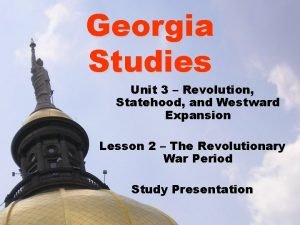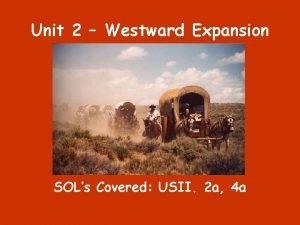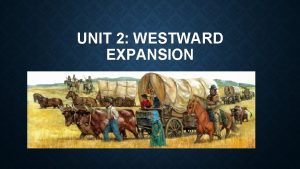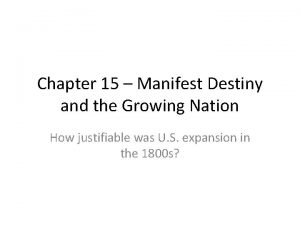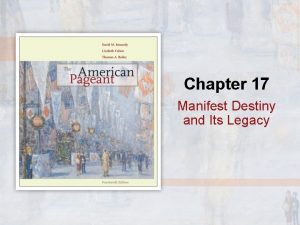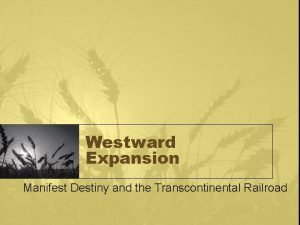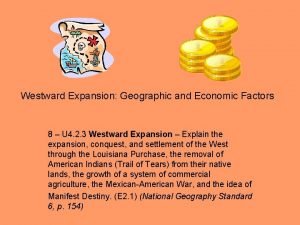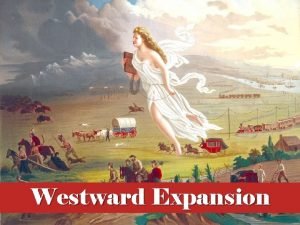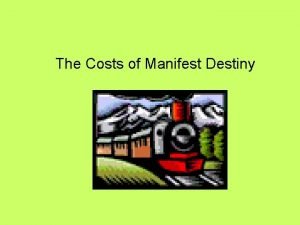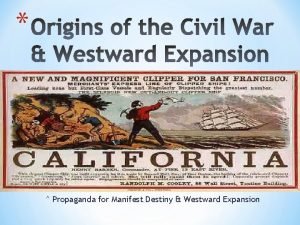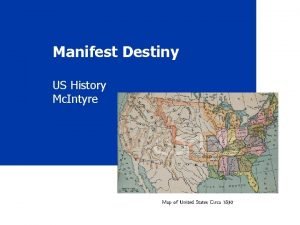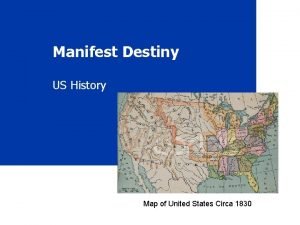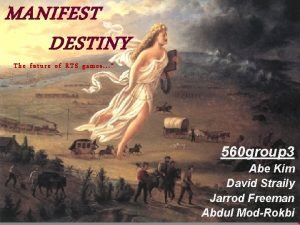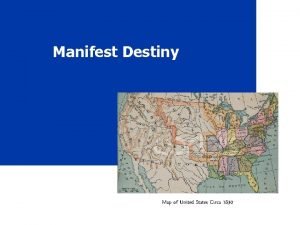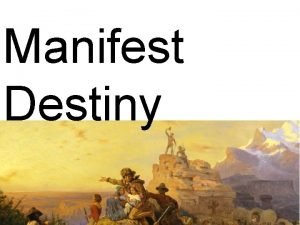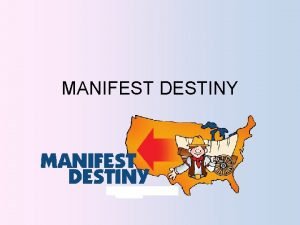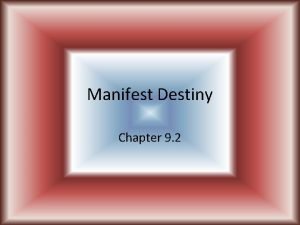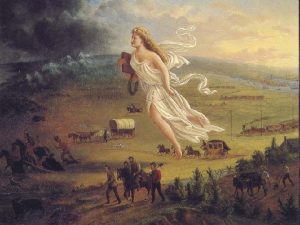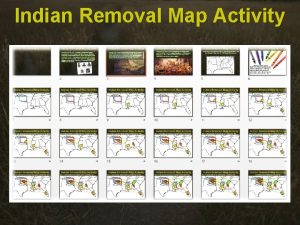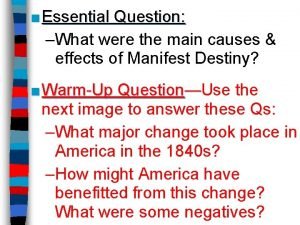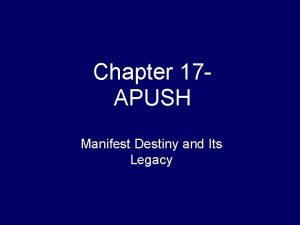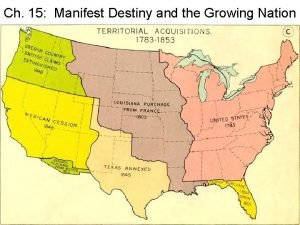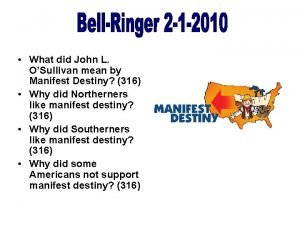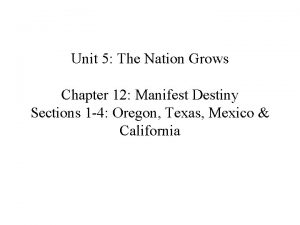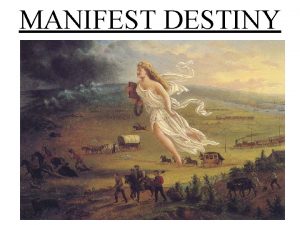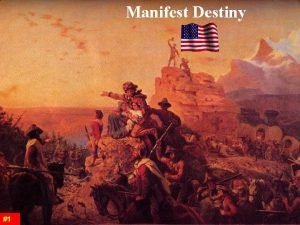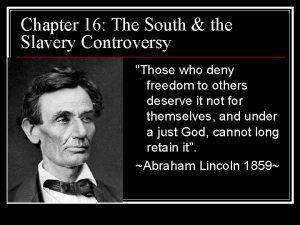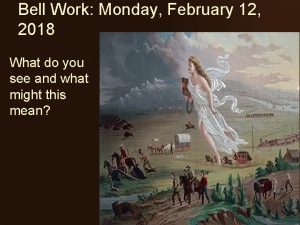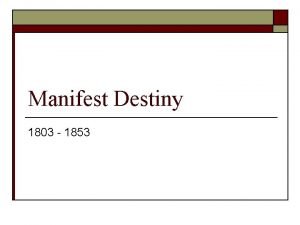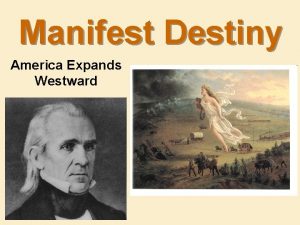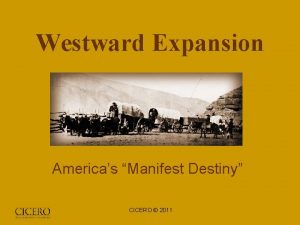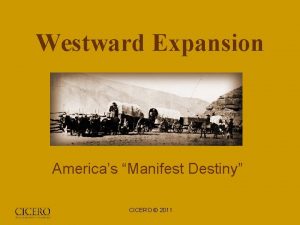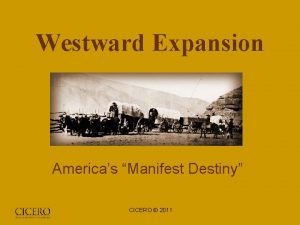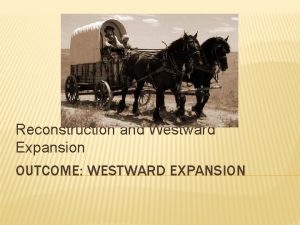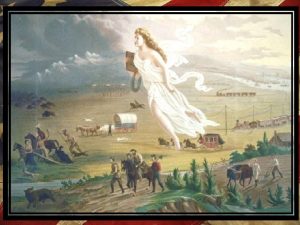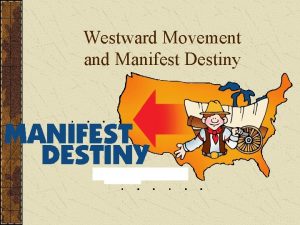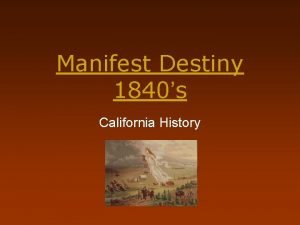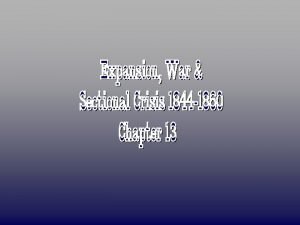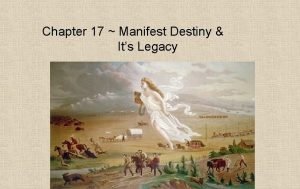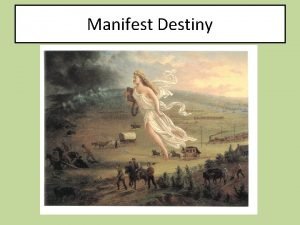Manifest Destiny and Westward Expansion Unit 5 Westward


































- Slides: 34

Manifest Destiny and Westward Expansion

Unit 5: Westward Expansion � Priority Standard 1: Analyze the concept of Manifest Destiny and its impact on the expansion of the United States. � Priority Standard 2: Compare and contrast motives for westward migration during the mid 1800”s. � Priority Standard 3: Explain how the Texas Revolution and the war with Mexico led to the territorial expansions of the mid-1800’s. � Priority Standard 4: Investigate to determine how Manifest Destiny impacted American Indians through wars, reservations and assimilation.

Big Ideas � The belief in Manifest Destiny inspired Americans to expand westward. � Economic opportunities drew many Americans westward. � The United States expanded through conflict and compromise. � Manifest Destiny drastically altered American Indians’ way of life.

Essential Questions � PS 1: What is Manifest Destiny? How does Manifest Destiny impact American ideals? How did Manifest Destiny impact American boundaries? � PS 2: How did Mountain men initiate westward expansion? What were the economic and religious reasons that Americans moved westward? How did pioneers migrate west? How did the gold rush lead to California statehood? What role did migrants play in westward expansion?

Essential Questions � PS 3: What economic opportunities drew Americans to Texas? Why did Texans revolt against Mexico? How did Texas annexation lead to war with Mexico? What was the outcome of the War with Mexico? � PS 3: How and why was the Oregon Territory acquired? What role did James K. Polk play in acquiring western territories? How does the map of the United States change as a result of Manifest Destiny?

Essential Questions – See Native American Cultures in Crisis Power Point Presentation. � PS 4: How did Manifest Destiny lead to the displacement of American Indians? How did American Indians respond to westward expansion? What were some of the conflicts that resulted from the US government’s attempts to subjugate American Indians? Why was the reservation system developed? How did the reservation system lead to the loss of tribal land? How did the Dawes Severalty Act attempt to assimilate American Indians? What was the impact of assimilation on American Indian culture?

Manifest Destiny Defined � Manifest Destiny was the belief that the United States was to spread its borders from the Atlantic to the Pacific Oceans. ◦ The phrase manifest destiny means “obvious fate. ” It was coined in 1845 by John O’Sullivan, a New York newspaperman. He wrote that it was America’s destiny to spread across North America. Realized under President Polk. John O’Sullivan

Settling the West � Mountain men trapping beaver pelts initiated the American movement to the West. � The rendezvous – a meeting between the trappers and traders to exchange the pelts for supplies – kept the flow of information about the West to the East. Fur trapping attracted mountain men to the West. Beaver Dam

Westward Trails � Trails that were created by the Mountain men, such as the Oregon Trail and the Santa Fe Trail (trade), were used by settlers in the move west. � The Old Spanish and California Trails were also used by settlers moving to the West and Southwest. All of the trails began in Illinois or Missouri.

Religious Reasons for Moving West � Some of the first settlers moved into the West to convert the local Indians to Christianity, something that met with mixed reactions and success. � Other religious groups, like the Mormons, moved west to escape religious persecution. Group of Mormon Settlers

Other Reasons/Motives for Moving West � Land, many pioneers were attracted to the rich soil of the Willamette Valley in present-day Washington and Oregon. � Economic hardships on the East Coast increased westward expansion. (Panics of 1837 and 1857) � Women pioneers were often given more rights in the West than they had been allowed in the East. Women helped bring education to the areas where they moved. One-room School House Wagon train

More Motives for Moving West � Escape debts or the law. � Change occupations. � Creation of new States. � Increased population/crowding in the East. � Spread the blessings of democracy and civilization. � Abundant forests and mineral resources. � Create/take advantage of new Western markets and trade with Asia.

More Motives for Moving West � Foreign ◦ ◦ affairs and territorial disputes. Texas Revolution and annexation. Mexican-American War. n o i t Mexican Cession. a r g i m California Gold Rush. Im � Government programs. ◦ The Civil War. ◦ Homestead Act of 1862. ◦ Pacific Railroad Act of 1862.

Pioneers and Native Americans � The pioneer push into the West and their demands for land increased tensions between Native Americans and white settlers. ◦ Attacks on settlers were not as common as the movies would have you believe. In most cases the whites were the aggressors. Indians attacking a Wagon-train.

Colonizing Tejas Stephen Austin � Stephen F. Austin led many American farmers into the Spanish land called Tejas to establish a colony there. ◦ Son of Moses Austin, who in 1821 was granted a huge tract of land in what is now Texas. When Moses died and Mexico won its independence from Spain, Mexico honored the agreement and allowed Stephen Austin and his people to establish a colony on the conditions that all colonists would be moral, hardworking people, that they would become Mexican citizens, learn Spanish, obey Mexican law and that they would convert to Catholicism.

Texan Independence Texas State Flag The Texas Revolution was caused by differing viewpoints between Americans living in Texas and the Mexican government. As a result, Texas briefly became an independent country before it was annexed into the United States. � Unrest throughout Mexico, including Texas, resulted in a coup by Antonio López de Santa Anna, who assumed the presidency in 1833. Texans, hopeful for relief from restrictive governmental measures, supported Santa Anna. � Austin expected a friendly hearing about these grievances but instead was imprisoned in Mexico City for encouraging insurrection. He was freed in 1835 and returned home to find that skirmishes had already developed between the colonists and Mexican troops and that Santa Anna was preparing to send reinforcements. �

Texan Independence � � Texans formed a provisional government in 1835, and in 1836 issued a declaration of independence at Washingtonon-the-Brazos. (Founded largely by immigrants from the southern United States(many owned slaves), Washingtonon-the-Brazos is known as "the birthplace of Texas" because it was here that, on March 1, 1836, Texas delegates met to formally announce Texas' intention to separate from Mexico and to draft the constitution of the new Republic of Texas. ) David G. Burnet was chosen as interim president of the new Republic of Texas, Sam Houston was appointed its military commander, and Austin became commissioner to the United States with the mission of securing strategic aid and enlisting volunteers.

Remember the Alamo � The famous siege of the Alamo in San Antonio lasted from February 23 to March 6, 1836. The strategic objective of the stand was to delay Mexican forces and thereby permit military organization of the Texas settlers. As the battle climaxed with a massive attack over the walls, the defenders (about 183) were all killed. Among the dead were the famous frontiersmen Jim Bowie and Davy Crockett. � On April 21 Sam Houston led a surprise attack on the Mexican troops at the San Jacinto River, where he succeeded in capturing Santa Anna and in securing victory for the Texans. Ruins of the Alamo

Texan Independence � The Sam Houston Texan revolution was not simply a fight between the Anglo-American settlers and Mexican troops; it was a revolution of the people who were living in Texas against what many of them regarded as tyrannical rule from a distant source. Many of the leaders in the revolution and many of the armed settlers who took part were Mexicans (Tejanos). General Santa Anna

From Independence to War � Disputes over the Texas/American/Mexican border led to a clash between Mexican and American soldiers on the Rio Grande and sparked the Mexican-American War. ◦ Prior to the war, diplomats were sent to Mexico to purchase California but were turned away without an audience. Frustrated, the Americans forced a showdown across the Rio Grande. The US said the attack was unprovoked, the Mexicans said it was. ◦ The US forces during the war were led by Zachary Taylor, Stephen Kearny, John Fremont, and Winfield Scott.

Bear Flag Revolt � The California State Flag American settlers in California revolted against Mexican rule and established (June 1846) the Bear Flag Republic, under John C. Fremont, before news of the Mexican. American War reached them. The Original Bear Flag

The Mexican American War 1846 -48 ◦ The war was won relatively quickly and easily. Some even contemplated taking all of Mexico and making it part of the US. ◦ The war was very important for several reasons. �First, it increased the size of the country by another third. �Second, it delayed the start of the Civil War by several years as the nation’s attention was redirected to war with Mexico and not the issues separating the North and South. �Third, the military leaders that would go on to fight in the Civil War gained valuable experience. �Last, the United States realized Manifest Destiny and the rest of the world was reminded that the US was a force to be reckoned with.

The Mexican American War � The Mexican-American War concluded with an American victory. The Treaty of Guadalupe Hidalgo gave the US the huge expanse of western land known as the Mexican Cession. ◦ Treaty that ended the Mexican-American War in 1848. Mexico agreed to give up Texas and a vast region known as the Mexican Cession. This area included the presentday states of California, Nevada, Utah, Arizona, and New Mexico, as well as parts of Colorado, and Wyoming. ◦ In return the US agreed to pay Mexico $15 million and promised to protect the 80, 000 Mexicans living in Texas and the Mexican Cession. Map of the Mexican Cession

The California Gold Rush John Sutter � The discovery of gold in 1848 at John Sutter’s mill sparked the California gold rush. ◦ On the morning of January 24, 1848, a carpenter named James Marshall, who was building a sawmill for Sutter upstream on the American River near Coloma, looked into the mill's tailrace to check that it was clear of silt and debris and saw at the water's bottom nuggets of gold. Marshall took his discovery to Sutter, who consulted an encyclopedia to confirm it was gold and then tried to pledge all his employees to secrecy.

The California Gold Rush � But within a few months, word had reached San Francisco and the gold rush was on. Suddenly all of Sutter's workmen abandoned him to seek their fortune in the gold fields. Squatters swarmed over his land, destroying crops and butchering his herds. "There is a saying that men will steal everything but a milestone and a millstone, " Sutter later recalled; "They stole my millstones. " By 1852 the gold rush had run its course, New Helvetia had been devastated and Sutter was bankrupt. He spent the rest of his life seeking compensation for his losses from the state and federal governments, and died disappointed on a trip to Washington, D. C. in 1880.

The Forty-Niners � The people who flocked to California in 1849 to look for gold were referred to as “Forty-Niners. ” ◦ The legacy of the forty-niners was a mix of positive and negative. Unfortunately the Native population was reduced from 150, 000 to about 30, 000, as a result of disease and greed. In addition, many Californios (Mexican land owners in California) lost their land. However, on the positive side, the population of California increased rapidly, enabling it to become a state in 1850 (skipped the territorial stage). The fortyniners also helped make California a diverse land of economic opportunity. ◦ Very few individuals “struck it rich, ” instead large mining operations moved into the area and took over, began strip-mining, damaging the environment.

The Homestead Act Poster � The Homestead Act of 1862 offered 160 acres of land free to anyone who agreed to live on and improve the land for 5 years. ◦ Passed during the Civil War when Democratic opponents could not block its passage. The Homestead Act of 1862 marked a drastic departure from previous land policy. Before the act, public land had been sold primarily for revenue; now it was to be given away to encourage a rapid filling of empty spaces and to provide a stimulus to the family farm – the backbone of democracy. During the 40 years after its passage, about ½ million families took advantage of the Act to carve out new homes in the vast open stretches. Yet 5 times as many families “purchased” their land from the railroads, the land companies, or the states.

The Oregon Territory � The United States and Britain decided to divide the Oregon Territory between them. ◦ At one time both Russia and Spain claimed the area, as well as the US and GB. The Spanish relinquished their claim to the area in the treaty that made Florida US territory in 1819. Russia signed a treaty with the US that limited their claim to the land in 1824 -25. Map of the Oregon Territory

The Oregon Territory � In 1846 the United States and Britain negotiated a treaty which gave the U. S. claim to all lands north of the 42 nd parallel, the current Oregon/California border to the 49 th parallel (excluding Vancouver Island) and east to the Continental Divide. � A provisional government was formed in 1845, which promptly lobbied the U. S. government for territorial status. The geographical region was officially formed as the Oregon Territory in 1848 and included the current states of Oregon, Washington, Idaho and western Montana.

The Gadsden Purchase � The Gadsden Purchase was a strip of land purchased by the United States from Mexico in 1853. The Treaty of Guadalupe Hidalgo (1848) had described the U. S. -Mexico boundary vaguely, and President Pierce wanted to insure U. S. possession of the Mesilla Valley near the Rio Grande, which was the most practicable route for a southern railroad to the Pacific. � James Gadsden negotiated the purchase, and the U. S. Senate ratified it by a narrow margin in 1854. The area of c. 30, 000 sq mi, purchased for $10 million, now forms the extreme Southern border of New Mexico and Arizona, South of the Gila River.

Themes of Manifest Destiny � (1) The virtue of the American People and their institutions. (Ethnocentrism) � (2) The mission to spread these institutions, thereby redeeming and remaking the world in the image of the US. (Ethnocentrism) � (3) The destiny under God to do this work. (Religion)

American Progress-Manifest Destiny

Analyzing Manifest Destiny � “American Progress, ” John Gast, 1872 Columbia: Female Personification of the US “Darkness” Pony Express (Temp. ) “Lightness” “Star of Empire” Buffalo Flee Destroyed School Book – Enlightenment Telegraph Wire Cities of the East Mississippi R. Railroads – Bind the Nation Covered Wagon (Perm. ) Stage Coach (Temp. ) Native Americans Flee Farmers/Settlers Homestead Act (Perm. ) Prospectors – Gold Rush (Temp. ) Wild Animals Flee Ms. Grant US History

Manifest Destiny Map $ - Purchase W – War T –Treaty/Peaceful *Original 13 Colonies 1607 *Proclamation Line of 1763 *Attempt to limit growth and expansion and prevent war with Native Americans. W W *French and Indian War 1754 -1763 Treaty of Paris of 1763 *American Revolution $ Treaty of Paris 1783 *US includes the territory between the Atlantic and Mississippi. *War of 1812 *Florida “Purchase” from Spain 1819 *Spain gives up claim to Oregon Country
 Jimmy fallon gadsden purchase
Jimmy fallon gadsden purchase Unit 3 rev. statehood and westward expansion
Unit 3 rev. statehood and westward expansion Unit 2 westward expansion vocabulary
Unit 2 westward expansion vocabulary Unit 2 westward expansion vocabulary
Unit 2 westward expansion vocabulary Lesson 15 manifest destiny and the growing nation
Lesson 15 manifest destiny and the growing nation Monroe doctrine and manifest destiny
Monroe doctrine and manifest destiny Chapter 17 manifest destiny and its legacy
Chapter 17 manifest destiny and its legacy Westward expansion lewis and clark
Westward expansion lewis and clark Transcontinental railroad manifest destiny
Transcontinental railroad manifest destiny Reasons for manifest destiny
Reasons for manifest destiny Facts about manifest destiny
Facts about manifest destiny Costs of manifest destiny
Costs of manifest destiny Westward expansion propaganda
Westward expansion propaganda Manifest destiny map
Manifest destiny map Manifest destiny map with dates
Manifest destiny map with dates Rts manifest
Rts manifest Us map 1830
Us map 1830 What is manifest destin
What is manifest destin Define manifest destiny
Define manifest destiny What is the main idea of manifest destiny
What is the main idea of manifest destiny Manifest destiny book
Manifest destiny book Indian removal act map activity
Indian removal act map activity Hailstones
Hailstones Manifest destiny poem
Manifest destiny poem His accidency apush
His accidency apush Travel in a growing nation answer key
Travel in a growing nation answer key Overland trails apush
Overland trails apush What did john l o'sullivan mean by manifest destiny
What did john l o'sullivan mean by manifest destiny Chapter 12 manifest destiny
Chapter 12 manifest destiny Manifest destiny effect
Manifest destiny effect What did manifest destiny predict?
What did manifest destiny predict? Manifest destiny
Manifest destiny American progress book
American progress book Manifest destiny
Manifest destiny How does this painting represent manifest destiny?
How does this painting represent manifest destiny?

